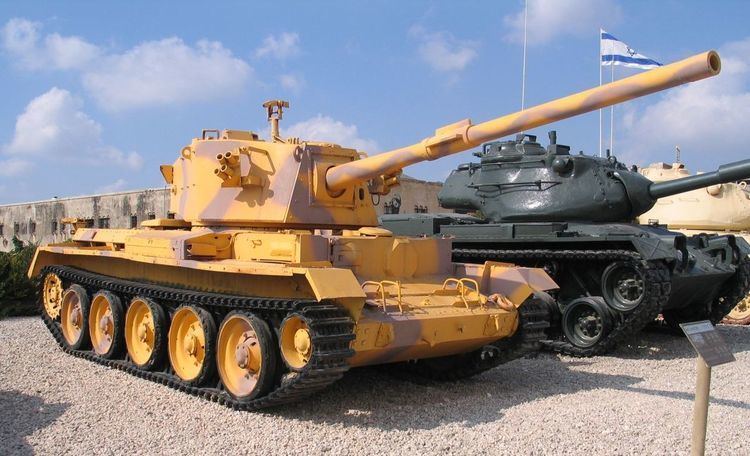Type Tank In service 1952 - 1980 | ||
 | ||
Manufacturer Robinson and Kershaw Ltd, Dukinfield, Cheshire | ||
The Charioteer Tank, or FV4101 Tank, Medium Gun, Charioteer was a post-war British armoured fighting vehicle. The vehicle was produced in the 1950s to up-gun units of the Royal Armoured Corps continuing to use the Cromwell tank during the early phases of the Cold War. The vehicle itself was a modified Cromwell with a more powerful gun installed in a relatively lightly armoured two-man turret.
Contents
Charioteer saw limited use with the British army, but saw more extensive use with overseas users in Europe and the Middle East. Charioteers saw action in conflicts in the Middle-East.
Development
In the early 1950s, plans to combat a potential invasion from Soviet forces during the Cold War called for a Royal Armoured Corps formation to be equipped with the Cromwell tank while Centurion tank numbers were still low. This required an up-gunning of Cromwell to incorporate the same 20 pounder (84 mm) gun as used in the Centurion Mk 3.
Mounting the gun required a new two-man turret to be developed. The resulting vehicle was initially named FV4101 Cromwell Heavy AT Gun, but renamed "Charioteer" before entering service.
Design
The new turret used the larger Ordnance QF 20 pounder gun. This was mounted with a co-axial 0.30 in M1919 Browning machine gun. Smoke grenade dischargers were fitted to both sides of the turret. A flap to the turret rear allowed spent shell casings from the gun to be ejected from the vehicle.
Hulls were based on the later Cromwell VII standard, modified with Comet Model B style fishtail exhausts and no hull-mounted machine gun. Most hulls were reworked to Type F standard, and fire extinguisher pulls were re-routed to the two track-side bins. A large armoured telephone box was fitted to the vehicle rear for communication with infantry. Additional defensive armour was welded to the Cromwell hull, but the upgrade focused on offensive capability and the new turret used much lighter armour (20–30 mm).
The turret ring was slightly increased in size to accommodate the larger gun, but the size limitation of the Cromwell hull meant that the new turret would need to be much larger and taller around it. This gave the vehicle a much higher profile.
Even with this size increase, stowage for the larger ammunition rounds was severely limited. The hull machine gunner's position was removed to provide additional stowage space for ammunition, but the vehicle still carried only 25 rounds. Some conventional High Explosive (HE) shells were carried, but the primary ammunition was Armour-Piercing Discarding Sabot projectiles (APDS)
A mixed collection of Cromwells were upgraded, resulting in a number of variations based on the vehicle's previous format.
Production
Building on the remaining Cromwell tanks as a basis, the tanks were converted by Robinson and Kershaw Ltd at their works in Dukinfield, Cheshire. While an expected production run of 630 was indicated in 1951, the production was cut short and the exact number produced is unclear. The first 200 were expected by March 1953 with a further 200 following in 1954. The actual number produced is believed to be 442.
Service
During development and manufacture the British Army went through two re-organisations, resulting in the tanks being reassigned to Royal Armoured Corps units of the British Territorial Army. These tanks replaced tank destroyers and self-propelled guns transferred from the Royal Artillery to the RAC during the re-organisation.
The number of vehicles required was cut, and only a small number entered service. Manufacturing of the modification was halted with around 440 of 630 vehicles completed. Surplus vehicles were sold to Austria, Finland, Jordan and Lebanon. The tanks were used by a number of forces in the Middle East through instability in the region, such as the Six-Day War.
While the vehicle was originally intended to operate with a 3-man crew, the commander's visibility from the turret was restricted during firing. This meant a 4th crew member was added as an external observer. The large size of the turret meant the vehicle was best used in a hull down position, firing over cover.
Operators
Variants
Production was based on a mixed fleet of Cromwell VI, VII, VIIw and VIII vehicles of mixed hull types. While all were upgraded to VII standard, some hull differences remained based on the vehicle's past. As a result, the vehicle continued to be known as Charioteer, Mks. 6, 7, 7w and 8 with hull types D, E and F.
The Ordnance QF 20 pounder was upgraded during production and service, and many vehicles were fitted with the later 20 pounder featuring a symmetrical fume extractor mid-barrel. Those without the fume extractor were dubbed Charioteer VIIA or Model A while those with the upgrade were named Charioteer VIIB or Model B.
In Jordanian Army use the vehicle was altered with upgraded electrically-driven turret traverse motors, and a larger commander's cupola mounting a .50 calibre machine gun. These traverse-motors were driven from a separate electrical supply. Different radio equipment was also fitted.
Beyond the original requirement, further up-gunning was attempted. A single vehicle was upgraded with the Royal Ordnance L7 105mm gun for trials in 1969. It was intended for export, and did not enter service. The gun is similar in appearance and based on the original, but can be distinguished by an offset fume extractor (larger at the top). This vehicle survives at the East of England Tank Museum.
